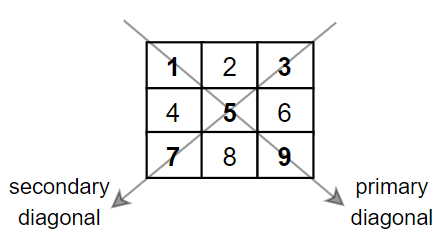- {x}
- Put Boxes Into the Warehouse I
- Unique Orders and Customers Per Month
- Detect Pattern of Length M Repeated K or More Times
- Maximum Length of Subarray With Positive Product
- Minimum Number of Days to Disconnect Island
- Number of Ways to Reorder Array to Get Same BST
- Dot Product of Two Sparse Vectors
- Warehouse Manager
- Matrix Diagonal Sum
- Number of Ways to Split a String
- Shortest Subarray to be Removed to Make Array Sorted
- Count All Possible Routes
- Replace All ?'s to Avoid Consecutive Repeating Characters
- Number of Ways Where Square of Number Is Equal to Product of Two Numbers
- Minimum Time to Make Rope Colorful
- Remove Max Number of Edges to Keep Graph Fully Traversable
- Put Boxes Into the Warehouse II
- Read More...

Matrix Diagonal Sum
Given a square matrix mat, return the sum of the matrix diagonals.
Only include the sum of all the elements on the primary diagonal and all the elements on the secondary diagonal that are not part of the primary diagonal.
Example 1:

Input: mat = [[1,2,3], [4,5,6], [7,8,9]] Output: 25 Explanation: Diagonals sum: 1 + 5 + 9 + 3 + 7 = 25 Notice that element mat[1][1] = 5 is counted only once.
Example 2:
Input: mat = [[1,1,1,1], [1,1,1,1], [1,1,1,1], [1,1,1,1]] Output: 8
Example 3:
Input: mat = [[5]] Output: 5
Constraints:
n == mat.length == mat[i].length1 <= n <= 1001 <= mat[i][j] <= 100
Solution Explanation for 1572. Matrix Diagonal Sum
This problem asks us to find the sum of elements in the primary and secondary diagonals of a square matrix, excluding the element at the intersection of the two diagonals (if the matrix has an odd number of rows and columns).
Approach:
The most efficient way to solve this is through direct iteration. We iterate through the rows of the matrix. For each row, we add the element at the index i (primary diagonal) and the element at index n-1-i (secondary diagonal) to the sum. We need a check to avoid double-counting the central element (when the matrix dimension is odd).
Code Implementation (Python):
class Solution:
def diagonalSum(self, mat: List[List[int]]) -> int:
n = len(mat)
total_sum = 0
for i in range(n):
total_sum += mat[i][i] # Primary diagonal
if i != n - 1 - i: # Avoid double counting for odd-sized matrices
total_sum += mat[i][n - 1 - i] #Secondary Diagonal
return total_sum
Time and Space Complexity Analysis:
-
Time Complexity: O(n), where n is the number of rows (and columns) in the square matrix. We iterate through the rows once.
-
Space Complexity: O(1). We only use a constant amount of extra space to store the
total_sum.
Code Implementation in other Languages:
The logic remains consistent across different languages. Here are examples in Java, C++, and Javascript:
Java:
class Solution {
public int diagonalSum(int[][] mat) {
int n = mat.length;
int totalSum = 0;
for (int i = 0; i < n; i++) {
totalSum += mat[i][i];
if (i != n - 1 - i) {
totalSum += mat[i][n - 1 - i];
}
}
return totalSum;
}
}C++:
class Solution {
public:
int diagonalSum(vector<vector<int>>& mat) {
int n = mat.size();
int totalSum = 0;
for (int i = 0; i < n; i++) {
totalSum += mat[i][i];
if (i != n - 1 - i) {
totalSum += mat[i][n - 1 - i];
}
}
return totalSum;
}
};Javascript:
/**
* @param {number[][]} mat
* @return {number}
*/
var diagonalSum = function(mat) {
let n = mat.length;
let totalSum = 0;
for (let i = 0; i < n; i++) {
totalSum += mat[i][i];
if (i != n - 1 - i) {
totalSum += mat[i][n - 1 - i];
}
}
return totalSum;
};All these solutions have the same time and space complexity as the Python solution. The core algorithm remains unchanged.